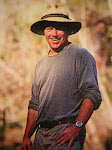For paddlers with an explorer's heart (and a good map) the vast, 53,000 acre Lower Suwannee National Wildlife Refuge is nothing short of paradise. It has it all. It is remote, wild and only requires an average amount of skill to paddle (but above-average amount of luck to navigate ;o). Best of all, this area is shrouded in misinformation. Given all this, it's no surprise that the backwaters of Lower Suwannee National Wildlife Refuge is among my favorite places to paddle. It's also one of our most requested tours. I lead an average of one tour per month into this quiet realm.
My favorite route carries us along a network of beautiful back-creeks and side-channels of the lower Suwannee River. The entire trip is within the bounds of the refuge. These low, tidal creeks and the coastal swamps they thread through are home to a fantastic array of birds, reptiles, amphibians and insect species. While the main channel of the Suwannee is relatively wide here (averaging 600 - 800 feet across), the back channels we follow rarely span more than 100 feet. Most are partially shaded by overhanging bald cypress, water elm, tupelo, ash, maple and oaks. The shrub layer is dominated by swamp dogwoods, Walter viburnum, buttonbush and climbing asters.
Sometimes, I do this tour as part of our "Wild Florida Chronicles" series, in which we follow the routes of some famous explorations. This segment of the series highlights the Chapman/Brewster expedition of 1890. While this team of famous naturalists only spent a couple of weeks exploring these same back channels (and the main river), their combined knowledge, along with with detailed notes and journal entries, left us a great written "snap-shot" of life along the lower Suwannee in the late 19th century. Most of the species they described are still here, including great blue, tri-colored. little blue herons, great and snowy egrets, prothonotary and parula warblers, swallow-tailed kites (in the summer) osprey and many more. The ivory-billed woodpeckers and Bachman's warblers they saw (and shot!) are now extinct.
Wildlife
The lower Suwannee is a bird-rich environment, with waders, shore birds, raptors and many others being well-represented. Bald eagles and osprey are common. In the summer, watch for Atlantic sturgeon, a migratory fish species that can get up to 200 pounds. From April through November, these silvery giants are often seen (and more often heard) jumping high out of the water. Manatees are also a possibility, especially in summer, as are swallow-tailed kites. One of the more surprising species you'll encounter are bottle-nosed dolphins. They often hunt in these waters for both freshwater and brackish water species such as redfish, bass, bream, sea-trout, catfish and mullet.History
The record of prehistoric human activity in the coastal lowlands near the mouth of Suwannee River is scant, compared to other parts of Florida. Numerous shell middens, located on barrier islands and on high ground along area waterways, stand as silent monuments to once-thriving communities that date back thousands of years to the Archaic period and continuing to up to the arrival of Europeans. However, during the first centuries of European exploration, conquest and settlement, this remote corner of the Gulf coast was largely bypassed.
Euro-American attempts at settling this area have always been small scale - rarely more than the optimistic efforts of homesteaders wanting simply to fish, hunt and raise healthy families. Needless to say, there is little documentation of these rare and fleeting endeavors. Those few settlements that involved more than just one or two families are known mostly from secondary sources and vague references and were very short lived.It was this remoteness and the unknown nature of this area that inspired three well-known naturalists, William Brewster, Dr. Charles Slover Allen and Frank M. Chapman,to embark on an exploration of discovery and nature study in 1890. In March of that year, the three men set off from New Branford, the town we know today simply as Branford) aboard a little "house scow" (a small houseboat) named the "Coota." For the next two weeks, they eased their way down the river, exploring side channels, taking notes and observing the wildlife. In keeping with the long-standing tradition of nature study, they shot as many animals as they could--great for detailed study of plumage and anatomy, not so great for species populations. Today's idea of nature conservation was still generations away.
Towards the end of their 70 mile journey, as they approached the Gulf, the explorer's spent increasing amounts of time stalking the back waters and tidal creeks. Here, among beautiful swamps of cypress, bay, tupelo and pumpkin ash, they were dazzled by a menagerie of bird species. Their final tally of 107 bird species, included some of the last ivory-billed woodpeckers recorded in Florida (one of which was shot). Also of interest were their sightings of Bachman's warblers. This species was named by John Audubon (though he never saw one alive) in honor of the birds discoverer, John Bachman. These birds, too, are probably extinct.
Today, the wild chorus of the Lower Suwannee swamps is a few singers short of what the Chapman and Brewster heard in the 1800's. But it's far from silent. Wildlife still abounds and ecosystems are still functioning. This is still a wild realm that I recommend to any paddler looking for raw nature.

3 comments:
good reading but the word is "explorers" not "explorer's." To make a word plural, just add an "s." When you add an apostrophe, you are making it possessive. Pretty basic.
You're reading it wrong. Read the first sentence of the piece and you'll understand the title is meant as possessive, not plural.
Post a Comment